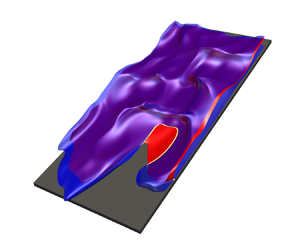Published online by Cambridge University Press: 15 June 2021

The present paper focuses on the structures and dynamics of flame edges in planar turbulent non-premixed flames bounded with a wall using direct numerical simulation (DNS). The global quenching behaviour was first examined and the flame edges were identified based on the intersections of mixture fraction and OH mass fraction iso-surfaces. For the upper branch of the planar jet flame, it is observed that the structures of flame edges change from tribrachial to monobrachial with increasing scalar dissipation rate. The flame edge speed is negatively correlated with the scalar dissipation rate in regions away from the wall, highlighting the role of turbulent mixing on the flame edge dynamics. During flame–wall interactions, the propagation speed of flame edges is mainly affected by the projection of edge flame normal in the wall-normal direction, i.e.  $\boldsymbol {N}_{Z}\boldsymbol {\cdot }\boldsymbol {N}_{wall}$. In particular, the propagation speed increases with increasing
$\boldsymbol {N}_{Z}\boldsymbol {\cdot }\boldsymbol {N}_{wall}$. In particular, the propagation speed increases with increasing  $\boldsymbol {N}_{Z}\boldsymbol {\cdot }\boldsymbol {N}_{wall}$ in the near-wall region. The interactions of flame edges and turbulence bounded with a wall are characterized by the alignment between edge flame normal and principal strain rates. The normal of quenching edges has a tendency to align with the most extensive strain rate
$\boldsymbol {N}_{Z}\boldsymbol {\cdot }\boldsymbol {N}_{wall}$ in the near-wall region. The interactions of flame edges and turbulence bounded with a wall are characterized by the alignment between edge flame normal and principal strain rates. The normal of quenching edges has a tendency to align with the most extensive strain rate  $\boldsymbol {e}_{1}$ in regions where the heat-release-induced dilatation is dominant over turbulent strain. In contrast, when the heat loss by cold wall effect is large enough to counteract the heat release induced by chemical reactions, turbulent strain is prevalent and the edge flame normal of the quenching edges preferentially aligns with the most compressive strain rate
$\boldsymbol {e}_{1}$ in regions where the heat-release-induced dilatation is dominant over turbulent strain. In contrast, when the heat loss by cold wall effect is large enough to counteract the heat release induced by chemical reactions, turbulent strain is prevalent and the edge flame normal of the quenching edges preferentially aligns with the most compressive strain rate  $\boldsymbol {e}_{3}$.
$\boldsymbol {e}_{3}$.